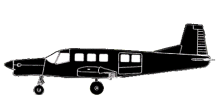
ASN Wikibase Occurrence # 198551
This information is added by users of ASN. Neither ASN nor the Flight Safety Foundation are responsible for the completeness or correctness of this information.
If you feel this information is incomplete or incorrect, you can submit corrected information.
| Date: | Thursday 3 December 2015 |
| Time: | 11:20 |
| Type: |  Pacific Aerospace 750XL |
| Owner/operator: | Paraclete Aviation Llc |
| Registration: | N216PK |
| MSN: | 114 |
| Year of manufacture: | 2005 |
| Total airframe hrs: | 4213 hours |
| Engine model: | Pratt & Whitney PT6A-34 |
| Fatalities: | Fatalities: 0 / Occupants: 1 |
| Aircraft damage: | Substantial |
| Category: | Accident |
| Location: | Raeford, NC -
 United States of America United States of America
|
| Phase: | En route |
| Nature: | Parachuting |
| Departure airport: | Raeford, NC (5W4) |
| Raeford, NC (5W4) | |
| Investigating agency: | NTSB |
| Confidence Rating: |
The commercial pilot of the single-engine turboprop airplane reported that he was preparing to release skydivers when he noticed that the engine torque indication was in the red arc. Specifically, the gauge was indicating a torque of 70 pounds per square inch (psi) when it should have been indicating about 25 psi; the maximum allowed torque indication was 64.5 psi. The skydivers jumped uneventfully. As the pilot was returning to the airport, the torque gauge was indicating 80 psi while the engine was at idle. At that time, the pilot decided to perform a precautionary engine shutdown and land with no engine power. During the landing, the airplane was fast and touched down about halfway down the 3,402-ft-long asphalt runway. The pilot applied heavy braking, but the airplane traveled about 1,000 ft beyond the departure end of the runway before coming to rest upright in a field with a collapsed left main landing gear.
Two examinations of the engine did not reveal any preimpact anomalies or evidence of overtorque. A test of the torque-indicating transducer and gauge also did not reveal any anomalies. The examinations did reveal that an automotive-type wiring bundle was used to wire the torque transducer to the airplane’s electrical system. Although it is possible that the wiring bundle could have caused an intermittent faulty torque indication, subsequent testing was unable to duplicate the problem. The airplane was manufactured about 10 years before the accident, and the torque meter manufacturer upgraded the wiring connectors about 4 years before the accident.
Probable Cause: The pilot's failure to obtain the proper touchdown point and speed during a precautionary landing with the engine shut down. Contributing to the accident was an erroneous engine torque indication, which led the pilot to shut the engine down, for reasons that could not be determined during postaccident testing.
Accident investigation:
 |
|
Sources:
NTSB
Location
Revision history:
| Date/time | Contributor | Updates |
|---|---|---|
| 19-Aug-2017 07:25 | ASN Update Bot | Added |
Corrections or additions? ... Edit this accident description
The Aviation Safety Network is an exclusive service provided by:


 ©2024 Flight Safety Foundation
©2024 Flight Safety Foundation